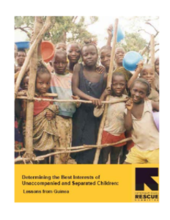In most refugee situations the majority of separated and unaccompanied children are reunified with their families. However, a number of children always remain for whom tracing is unsuccessful despite extensive and comprehensive efforts. It is for these children that formal Best Interest Determination (BID) procedures are implemented to safeguard their rights and identify the most appropriate durable solution (voluntary repatriation, local integration, resettlement) to ensure their overall well-being. This report provides some practical recommendations for the establishment and implementation of Best
Interest Determinations (BID)/ Durable Solutions (DS) mechanisms for separated children, based on the BID/DS process in Guinea for Sierra Leonean separated children.
According to UNHCR’s Guidelines on the Formal Determination of the Best Interests of the Child (provisional release, May 2006), (‘BID Guidelines’) “decisions to identify durable solutions for unaccompanied and separated children generally require a complex balancing of relevant factors and rights in each individual case. The inherent complexity of such a decision, combined with the fundamental and long-term impact on the child’s life, require a formal BID procedure…” The BID Guidelines outline three situations in which a formal BID is required for children of concern to UNHCR:
- To decide on temporary care arrangements for unaccompanied and separated children in particularly complex situations;
- To decide on the separation of a child from his or her parents against their will;
- To identify durable solutions for unaccompanied and separated children.
Based on the BID experience for Sierra Leonean unaccompanied and separated refugee children in Guinea, this report focuses only on the third situation- identifying durable solutions for unaccompanied and separated children. The report is not meant to provide comprehensive recommendations, but rather to build on and complement UNHCR’s BID Guidelines, which serve as the primary methodological framework on formal Best Interest Determinations and Durable Solutions for unaccompanied and separated children.
A key lesson from the Guinea experience is the importance of setting in place a formal BID process from the beginning of an emergency. This process should not operate in a vacuum, but rather work within the framework of an overall Unaccompanied and Separated Children programming strategy. It is also essential to ensure the involvement of relevant child protection agencies and provide adequate capacity building support.
©International Rescue Committee

